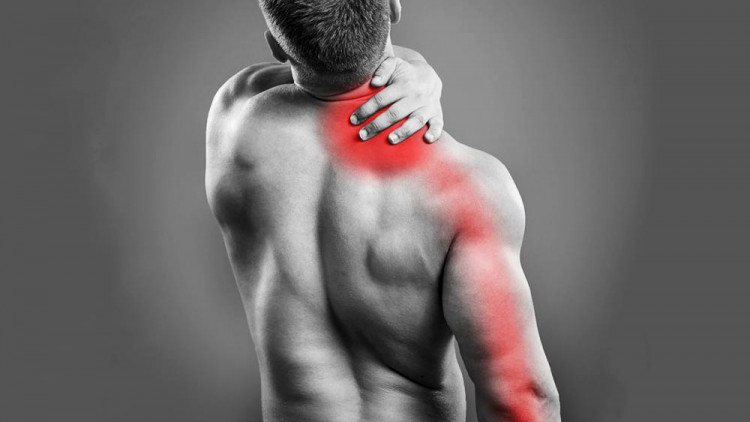Do you sometimes feel like your neck is a bundle of knots? Do you have pain in your neck that seems to get worse when you are stress ?
If so, you may be suffering from cervico-brachial neuralgia. This condition is caused by compression or irritation of the nerves that pass between your neck and shoulder.
In addition to pain, sufferers may experience tingling, numbness, or weakness in the arm or hand. the stress can play a major role in exacerbating this condition.
Cervical Spine Anatomy
La cervical spine is made up of seven vertebrae, designated by the letters C1 to C7. These vertebrae are stacked on top of each other and separated by intervertebral discs.
The discs act as shock absorbers, cushioning the bones and absorbing impacts. The cervical vertebrae are relatively small and fragile, and they support a lot of weight due to their location at the top of the spine.
The spinal cord passes through the central canal of the vertebrae, and nerves branch from the spinal cord to innervate the neck and arms.
The vertebrae are interconnected by facet joints, which allow a limited range of motion in the neck. The bones, discs, nerves and muscles of the cervical spine work together to support the head and allow a wide range of motion.
La cervico brachial neuralgia what is it ?
La cervico brachial neuralgia is a condition that results from compression or irritation of a nerve in the neck. The pain associated with this condition can affect the neck, collarbone, upper back, shoulder, and arm on one or both sides of the body.
The term “neck sciatica” or “arm sciatica” is often used to describe this condition because the pain radiates from the neck down the arm.
Symptoms of cervico-brachial neuralgia
La cervico brachial neuralgia is a condition that causes extreme pain in the neck, shoulders and arms. The pain is often described as an electric shock sensation and can make it difficult to perform daily tasks.
Other common symptoms are numbness, tingling, headache, and dizziness. This condition is thought to be caused by compression of the nerves in the cervical spine and can often be relieved with medication or surgery.
If you have any of these symptoms, it is important to see a doctor for a correct diagnosis.
The main causes of cervico-brachial neuralgia
La cervico brachial neuralgia (NCB) is a relatively common and debilitating pain syndrome. This pain can be aggravated by neck movements, coughing or sneezing.
The cause of the cervico brachial neuralgia is often unknown, but has been linked to certain activities or conditions, including:
- Smoking: Smoking is a major risk factor for developing cervico-brachial neuralgia. Studies have shown that smokers are more likely to develop CBN than non-smokers. The reason for this phenomenon is not fully understood, but it is believed that smoking can damage the nerves or blood vessels in the neck.
- Bad posture: Poor posture can put pressure on the muscles and nerves in the neck. This can lead to irritation and inflammation of the nerves, causing pain.
- Genetic factors: Certain genetic factors can predispose people to develop cervico-brachial neuralgia.
- Acute or repeated trauma: Acute trauma, such as a car accident, can damage the nerves in the neck. Repeated trauma, such as carrying a heavy backpack, can also lead to cervico-brachial neuralgia.
- Tumors : Tumors or growths in the neck can compress nerves and cause pain.
- Occupational activities exposed to vibrations or the carrying of loads: Jobs involving exposure to vibration, such as using a jackhammer, can damage nerves in the neck and lead to cervico-brachial neuralgia.
- La cervical spondylosis : It is a degenerative condition of the spine that can compress nerves and cause pain.
- Le stress : The stress has a physical effect on the neck muscles, increasing muscle tension. It can increase or trigger neck pain. Also, chronic neck pain tends to increase the stress, thus creating a vicious circle.
How is stress related to cervico brachial neuralgia ?
It is no secret that the stress can affect our physical and emotional health. When we're stressed, our bodies go into "fight or flight" mode, releasing hormones like adrenaline and cortisol.
These hormones are designed to help us deal with dangerous situations, but when constantly released they can lead to a host of problems including high blood pressure, heart disease, obesity, muscle tension in all body including the neck and spine (the back in general) anxiety and depression.
The effect of stress on the immune system
Le stress can have profound effects on the immune system. When you're stressed, your body produces fewer antibodies and it's harder for it to fight infections.
This can lead to increased susceptibility to colds, viruses, and other illnesses. the stress also changes the way the body reacts to inflammation. This can aggravate inflammatory conditions like arthritis.
The effect of stress on muscles and nerves
Le stress also triggers physical reactions like increased muscle tension and decreased blood flow.
These changes can lead to headaches, back pain, and other physical symptoms. the stress also sensitizes your nervous system, making you more sensitive to pain and more likely to suffer from anxiety or depression.
Cervico brachial neuralgia and stress: what to do?
Fortunately, there are a number of things we can do to manage our level of stress and protect our health.
Exercise, physical therapy, relaxation techniques like yoga or meditation, and spending time with friends and family can all help reduce stress.
How to manage your stress
If some people are able to manage their stress changing their lifestyle or taking care of themselves, others may need professional help.
Mental health professionals can offer different types of treatment for stressIncluding cognitive-behavioral therapy, which helps patients identify and change their negative thought patterns.
Relaxation techniques such as deep breathing and progressive muscle relaxation and exposure therapy, which involves gradually exposing patients to things they fear.
In some cases, medication may also be prescribed to help manage the stress. For those who prefer not to take medication or want to supplement their medical treatment, there are also a number of alternative therapies that may be effective.
These include acupuncture and massage. By exploring all of the available options, people can find the treatment that is best for them and set themselves on the path to effective management of their stress.
References
- https://www.lombafit.com/nevralgie-cervico-brachiale/
- https://www.reflexosteo.com/blog-sante-bien-etre/mal-au-cou-et-si-c-etait-le-stress-101
- https://toutpourmasante.fr/douleurs-cervicales-stress/
- https://mon-osteo-paris.fr/nevralgie-cervicobrachiale/



